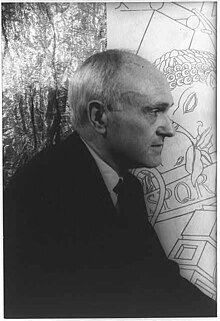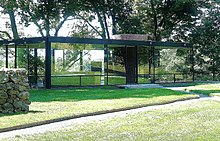Philip Johnson
Philip Cortelyou Johnson (born July 8, 1906 in Cleveland , † January 25, 2005 in New Canaan, Connecticut ) was an American architect and architecture critic .
Together with Henry-Russell Hitchcock, he coined the term International Style for the modern architecture of the time in the 1930s . He later became one of the co-founders of postmodernism .
Life
Philip Johnson was born the son of the wealthy lawyer Homer Hosea Johnson (1862-1960) and his wife Louisa Osborn Pope (1869-1957). Through his mother, he was a first cousin of the architect Theodate Pope Riddle . He had two sisters, Jeanette and Theodate. As his most memorable experience, he later described visiting Chartres Cathedral as a child with his mother. He studied philology at Harvard University . From 1930 to 1936 he headed the architecture department at the Museum of Modern Art in New York City . In 1932, together with Henry-Russell Hitchcock, he published the publication "The International Style: Architecture since 1922" (German: 1985), which was published for the exhibition of the same name. Using selected examples of European architecture from the previous decade, this traced modern architecture back to three basic principles: architecture as volume, regularity as a means of order, decoration as not allowed. Although Johnson and Hitchcock did not consider many aspects of the avant-garde architecture of the time, the new style soon became an established concept in architectural history.
Johnson is accused of sympathizing with the ideas of National Socialism in the 1930s and expressing anti-Semitic ideas. As early as 1941, William L. Shirer referred to him in his book Berlin Diary (1934-1941): The Journal of a Foreign Correspondent as a fascist and representative of Charles Coughlin's Social Justice . In later years, Johnson distanced himself from this stance. When asked about it in a July 8, 1996 television interview with Charlie Rose , Johnson expressed remorse.
From 1940 to 1943 Philip Johnson completed an architecture degree at Harvard with Walter Gropius and Marcel Breuer . From 1942 Johnson worked as a freelance architect in Cambridge. In 1946 he was again director of the architecture department at the New York Museum of Modern Art. In 1947 he organized an exhibition there on Ludwig Mies van der Rohe . With his own house, the Glass House in New Canaan, which only contains the wet cell as a bricked core and has four outer walls made of glass, he propagated the concept of a one-room house . The Farnsworth House by Ludwig Mies van der Rohe served as a model . Johnson built even more spacious, light-flooded bungalows in New Canaan, which are in the tradition of Mies van der Rohe's Barcelona pavilion , with open floor plans and lots of glass. In 1953 he designed the sculpture courtyard of the Museum of Modern Art in New York. Together with Mies van der Rohe, he built the Seagram Building in New York from 1954 to 1958 , which is considered a milestone in modern architecture.
At the same time, Johnson changed the language of forms in his designs, radical functionality was replaced by mannerist, playful forms. The focus now was on giving the building an unmistakable identity. Johnson thus pioneered postmodern architecture. Colored window slits, symmetrical rows of arches and closed, heavy bodies can be found in his buildings from the sixties.
In 1967 the architect John Burgee became his business partner. From the 1970s onwards, Johnson / Burgee built a number of remarkable skyscrapers together, which set striking accents in the cityscape through the use of historicizing architectural quotations on the facades. One of his designs is the AT&T high-rise in New York City from 1984, one of the most famous buildings in the style of postmodernism . In other buildings, Johnson used elements of ancient Roman architecture.
With the exhibition “Deconstructivist Architecture”, which he organized with Mark Wigley at MoMA in 1988, he helped deconstructivist architecture to break through.
Johnson was also active in Germany: for example, he designed the Bielefeld Kunsthalle, which was inaugurated in 1968 . From 1994 to 1997 there was an office center in Berlin on Friedrichstrasse , not far from the former Checkpoint Charlie border crossing , which bore his name.
After Johnson died in January 2005, his long-time partner David Whitney followed him a few months later on June 12, 2005.
Five months after Johnson's death on September 12, 2005, construction of the Urban Glass House on New York's Spring Street began posthumously . The completion took place in 2006.
Awards
Philip Johnson received First Prize from the American Institute of Architects in 1961 for the Roofless Church in New Harmony, Indiana . In 1963, Philip C. Johnson was elected a member ( NA ) of the National Academy of Design in New York . In the same year he was made a member of the American Academy of Arts and Letters , and in 1977 a member of the American Academy of Arts and Sciences . In 1979 he was the first to be awarded the Pritzker Prize .
buildings
Philip Johnson planned the following buildings, among others:
- 1947-1949 Glass House , New Canaan
- 1953 Abby Aldrich Rockefeller Sculpture Garden at the Museum of Modern Art , New York City
- 1954–1956 Synagogue in Port Chester
- 1960 Roofless Church, New Harmony, Indiana , with Jacques Lipchitz
- 1961 Amon Carter Museum , Fort Worth
- 1960–1963 Sheldon Memorial Art Gallery, Lincoln (Nebraska)
- 1962–1965 Kline Geology Laboratory, Yale University , New Haven (Connecticut) , with Richard Foster
- 1964 New York State Theater and Lincoln Center Fountain, Lincoln Center , New York City
- 1966–1968 Kunsthalle Bielefeld , Bielefeld
- 1967 Kreeger Museum , Washington DC
- 1970-1976 Pennzoil Place, Houston
- 1976 Thanks-Giving Square with Chapel of Thanksgiving, Dallas
- 1971 Public Library Addition, Boston
- 1979–1984 Pittsburgh Plate Glass Building , Pittsburgh , Pennsylvania
- 1980 Crystal Cathedral , Garden Grove (California)
- 1980–1984 AT&T Headquarters , New York City (today: Sony Tower)
- 1984 Transco Tower (today: Williams Tower), Houston
- 1986 Lipstick Building , New York
- 1989 500 Boylston Street, Boston
- 1990 Crean Tower, Garden Grove, California
- 1995 Gate House, New Canaan
- 1996 Puerta de Europa , Madrid
- 1994–1997 Philip Johnson House at Checkpoint Charlie , Berlin
literature
- David A. Hanks, Friedrich Meschede (eds.): Partners in Design: Alfred H. Barr Jr. and Philip Johnson: Bauhaus Pioneers in America , Stuttgart: Arnoldsche Art Publishers [2017], ISBN 978-3-89790-496- 5 .
Web links
- Literature by and about Philip Johnson in the catalog of the German National Library
- Images of his buildings (English)
- Philip Johnson Pritzker Architecture Prize Laureate 1979
- Interview with Charlie Rose, July 8, 1996
- Hanno Rauterberg : “ The great changer ” - Interview in: Die Zeit No. 29/2002, p. 34
Individual evidence
- ↑ Robert AM Stern : Philip Johnson: An Essay
- ↑ Kazys Varnelis: We Cannot Not Know History: Philip Johnson's Politics an Cynical Survival ( Memento of the original from November 8, 2010 in the Internet Archive ) Info: The archive link was automatically inserted and not yet checked. Please check the original and archive link according to the instructions and then remove this notice. , Journal of Architectural Education , November 1994.
- ^ I share a double room in the hotel here with Phillip Johnson, an American fascist who says he represents Father Coughlin's Social Justice. Report from Shirer
- ↑ nationalacademy.org: Past Academicians "J" / Johnson, Philip C. NA 1963 ( Memento of the original from April 2, 2015 in the Internet Archive ) Info: The archive link was inserted automatically and has not yet been checked. Please check the original and archive link according to the instructions and then remove this notice. (accessed June 27, 2015)
- ^ Museum of Modern Art: A Modern Garden: The Abby Aldrich Rockefeller Sculpture Garden at the Museum of Modern Art . New York 2007; Joachim G. Jacobs: MoMa New York. Philip Johnson's sculpture garden. A key work of the "International Style" . In: Die Gartenkunst 17 (1/2005), pp. 1–21.
| personal data | |
|---|---|
| SURNAME | Johnson, Philip |
| ALTERNATIVE NAMES | Johnson, Philip Cortelyou (full name) |
| BRIEF DESCRIPTION | American architect and architecture critic |
| DATE OF BIRTH | July 8, 1906 |
| PLACE OF BIRTH | Cleveland |
| DATE OF DEATH | January 25, 2005 |
| Place of death | New Canaan, Connecticut |







